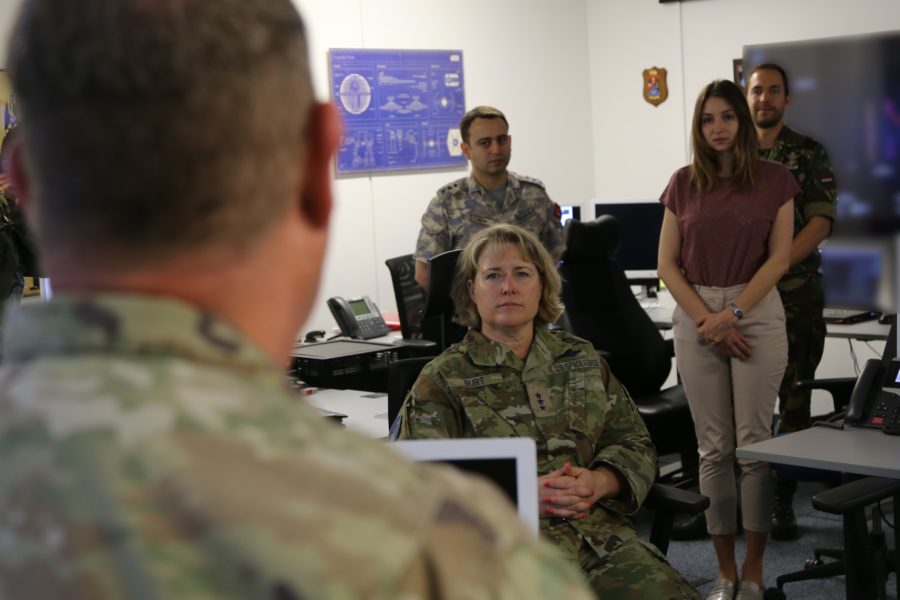With the Space Force on the precipice of standing up its own European component, the service is studying how it will work within NATO, the continent’s primary military framework.
To that end, Lt. Gen. DeAnna Burt, deputy chief of space operations for operations, cyber, and nuclear, traveled to Germany and the United Kingdom late last month.
In Germany, Burt met with NATO space operations personnel “to learn and understand how the U.S. can best integrate and support the alliance’s space mission,” according to a news release.
Both the Space Force and NATO are still figuring out how the alliance will use space capabilities.
“We’re also talking about now what does this mean,” Burt told reporters after the visit, which ran from May 22-26. “Space has been identified as a new domain under NATO.”
After NATO’s declaration that space was the “fifth domain” in 2019—the year the the Space Force was created—the alliance set up a dedicated Space Center in 2020. In 2021, NATO said “attacks to, from or within space” could lead to the invocation of the alliance’s Article Five mutual defense clause. Much like the Space Force’s original operating construct, NATO’s space operations are part of NATO Allied Air Command, which is led by U.S. Air Force Gen. James B. Hecker, at Ramstein Air Base, Germany.
But the Space Force is in the process of breaking out its own space components under different geographic combatant commands.
“The United States decidedly has been doing space for a long time but has not broken it out as a separate service and its own combatant command until recently,” Burt said. “So there’s a lot of learning going on and sharing of what we’ve learned as we’ve traveled this road on the U.S. side, sharing with our partners.”
According to a readout of the trip from the Space Force, Burt also traveled to London to discuss space operations with the British military, which recently stepped up its military capabilities in space.
Soon, the Space Force will create its component inside U.S. European Command. Right now, the service is preparing to transfer its existing space operations, part of U.S. Air Forces in Europe, into a component separate from the Air Force but with little immediate change in staffing, Burt said. That would create a similar arrangement to U.S. Central Command’s space component, which kept existing personnel but made its commander Col. Christopher Putman independent of Air Forces Central boss Lt. Gen. Alexus G. Grynkewich in an effort to gain a bigger voice for the service.
“It only makes sense as the newest service that we are also standing up our own service components,” Burt said. “So we’re repurposing those personnel who are already there in that Director of Space Forces element, and now pulling them out and establishing them as a service component to U.S. EUCOM.”
For now, she said, those forces plan to remain where they are at Ramstein, and the command will officially be authorized by Secretary of Defense Lloyd J. Austin III.
“While that is pending and we’re working that official letter, we are doing mission analysis on the number of people that it’s going to take to execute that mission and to support U.S. EUCOM,” said Burt, who added the DOD was also exploring if Ramstein should be the permanent hub for the USSF on the continent.
As the Space Force begins to find its footing as an independent service, it has recently articulated the concept of “responsible counterspace campaigning,” dipping its toe into the prospect of offensive missions in space to ensure the service can continue to support of the U.S. military.
“My job is to be prepared to fight tonight if asked by the nation. How do we do responsible counterspace campaigning?” Burt said. “And those words are very specific: responsible. Do we have responsible norms of behavior of how we operate in the domain?”
NATO has been bolstered recently with increased defense spending and a new member after Russia’s invasion of Ukraine. Kyiv has been heavily reliant on space capabilities, using commercial assets such as SpaceX’s Starlink and satellite imaging to aid its war effort. Russia, in turn, has sought to disrupt those capabilities.
But for Burt, one of the main lessons to come out of the war doesn’t come from space, but from the air. Commercial traffic avoids Ukrainian airspace lest it be caught in the crossfire, which already happened in 2014 when Russian-backed forces shot down a civilian airliner. That offers a stark lesson, she said, for any nation contemplating conducting a war in space, which Burt noted had distinct dangers from a conflict that uses space assets to support other domains.
“When you look at Ukraine from an air perspective, all the commercial traffic goes around Ukraine,” Burt said. “Nothing is flying directly over Ukraine or the battlespace. That’s how we are protecting noncombatants. They don’t go into the area of responsibility or the danger area. We can’t do that in space. Everyone is in the engagement zone if we were to have a war that extended into space, which is why it is not something that we want to do.”
